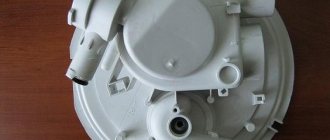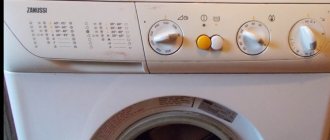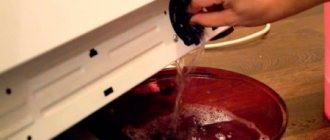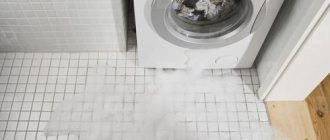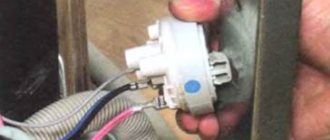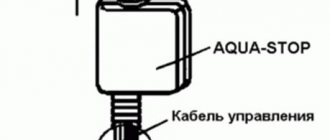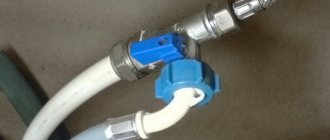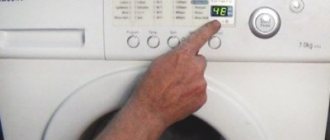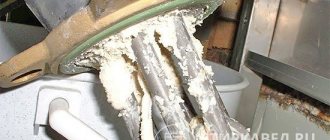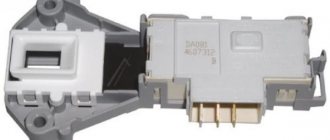You loaded the dishes into the home assistant, set the program, the unit started up, and the normal washing process began. But something went wrong - the dishwasher does not drain the water and stands still, and instead of the usual murmur of water, strange sounds are heard or an incomprehensible silence hangs. The situation is unpleasant, but it is not difficult to cope with. How?
In the article, we examined in detail the probable causes of malfunctions, suggested options for eliminating simple and serious breakdowns, and also described how problems in the drainage system of dishwashers from different manufacturers are signaled.
Standard error codes for popular models
Many modern dishwashers (dishwashers) have a self-diagnosis option. It is embedded in the software module. The machine, using certain algorithms, identifies the failure and displays it on the screen in the form of a specific code.
The depth of such analysis depends on the manufacturer, model, and generation of the control module.
The self-diagnosis system is capable of recognizing up to 200 different breakdowns. The option brings great benefits to both repair specialists and users themselves.
Error codes for some manufacturers:
- Bosch - E21-E25, END.
- Electrolux - END, i20, E24, E21.
- Ariston - TO03.
- Electrolux - i20.
- Candy - E2.
If the dishwasher does not have a display, flashing sensors will indicate a breakdown. How exactly this will happen depends on the model; usually the explanation of the light warning is given in the instructions.
Some Bosch modifications do not react in any way to problems in the drainage system and continue to wash dishes in used water. The user learns about the breakdown only after opening the door at the end of the program, when he sees that there is water in the tank.
How to reset error codes? There are two ways. The first is to turn off the PMM for 15-20 minutes so that it restarts. The second is to click on “On.” and hold for some time. This resets the user settings and returns them to factory settings.
Symptoms of a problem
Of course, the main evidence of a lack of normal operation is the water remaining in the washing compartment. But in a Bosch brand dishwasher, its presence can only be determined after the job is completed. Here the liquid is used in a closed cycle, through a filtration system; the pump begins to pump it out at the end of the cycle.
You can verify the malfunction by visual inspection, after stopping work, by opening the washing compartment. Other models, where draining occurs periodically, may stop working without completing the wash. In addition to liquid residues, audio and visual indications can be evidence of a malfunction. On machines without a display, the indicator light and sound signal turn on; if the display is present, the corresponding error code appears on it.
| Car | Error code |
| Bosch | E24 |
| Ariston | TO 03 |
| Electrolux | I20 |
| Candy | E20 |
| Indesit | TO 06 |
| Eyelid | H5 |
The principle of water movement in a dishwasher
If other problems can be dealt with after the fact, without understanding the reasons, then the lack of drainage requires a detailed analysis. And the first thing you should understand is the operating principle of the PMM.
The dishwasher does everything almost like a washing machine, only in the process it moves water twice through its cleaning system.
Each washing stage ends with draining the water. If the dirty liquid is not discharged, the machine is not able to proceed to the next step of the program
First, coarse filtration occurs, then fine filtration. Average water consumption is 9-12 liters. Savings are achieved through constant purification of the same water. After the filter, the liquid enters the pump and returns to the rocker arm and sprinklers.
At the end of the program selected by the user, the water goes down, and the drainage pump sends it to the sewer system. This does not happen if some element of the drain system does not work correctly or is completely out of order.
Debris accumulation in the drain pump
Most often, the dishwasher does not drain water due to a clogged drain pump located at the bottom of the unit. Some models of similar equipment make it easy to remove the part and clean it. However, in some cases, design features do not allow this to be done. To fix the problem, you need to dismantle the element, remove the blockage, and then check the internal impellers. You can use a pencil to determine how they rotate. You should work with extreme caution, as the cork is usually formed as a result of the accumulation of small fragments of dishes, which can easily injure.
If, after removing the blockage, the Bosch dishwasher fills up and does not drain water or does not start at all, then the problem of malfunctions may be much more serious, and it is simply impossible to eliminate it without the help of specialists.
Simple faults and their elimination
When the machine does not drain water, there are two answers to the question of what to do - remove physical obstacles in the drainage system or replace the broken part.
Any PMM operating manual states that you should not neglect the simple rule - clean the dishes from food residues before loading them into the chamber. Debris is the main cause of drainage problems.
#1 - kinked or clogged drain hose
A pinched drain hose is a simple but not the most common problem. Check how it is positioned. The part may be bent or pinched by some object. A blockage may form in the pressed area.
If it is impossible to clean the hose or it is damaged, the part needs to be replaced. You can buy a new tube at any hardware store.
It would also be a good idea to press on all the elastic pipes to liquefy the dirt.
To remove the hose and clean it, you need to:
- Disconnect the machine from the power supply.
- Remove the panel from below the door by removing the screws.
- Disconnect the hose from the sewer using pliers to remove the clamp.
- We lower one end of the tube into a bucket (pan) and turn on the drain mode. If water flows from it, the sewer or siphon is clogged (we will consider this case below). If there is no water, the problem is hidden in the machine itself.
- We knock the garbage out of the hose.
- We pass a powerful pressure of water through the tube, for which a garden hose is ideal. The pressure will dislodge any remaining debris.
- You can clean the hose with a long wire, but be careful. To avoid damaging the tube itself, round the end of the wire with a bend.
When the hose is cleaned or you bought a new one, connect it back, replace the clamp and the bottom panel. The tube should be inclined - go slightly up and down from the machine. If everything is in order, look further.
#2 - food residues in the filtration system
The problem with the drain may be a banal bone that has jammed the filter assembly. If you look into this compartment, on some PMM models you can see a screw, which, when unscrewed, will get to the gear. It gets jammed with small debris. You need to remove everything unnecessary for the gear to start.
Cleaning PMM filters:
- Open the door and take out all the baskets.
- Unscrew the filter cap, which is located at the bottom of the chamber.
- We take out the glass and the mesh.
- We wash both parts. If you can’t do this simply under running water, a toothbrush and detergent will come in handy.
- We unscrew the drain pump cover and check this place for debris. Be careful, not only food remains can get here, but also broken dishes.
After all the manipulations, close the pump and return the filter to its place.
Don't forget to clean the impeller and rocker arms. We remove them one by one, wash them, and clean the holes with a toothpick. If they rotate poorly after assembly, remove scale from the axle as well.
Are you sure everything is ok? Test the machine.
#3 - garbage in the sewer
If water flows from it when you disconnect the drain hose, the PMM is working properly, and the problems are hidden in the sewer. Causes of blockage: impurities in water, corrosion of pipes, dirt and grease washed off from dishes. Minor debris can be removed with ordinary boiling water - it must be poured into the sewer hole.
Several effective ways to clean drains:
- Soda + salt . Add soda and salt to a glass of hot water, dissolve it, pour it down the drain, wait 10 minutes and rinse with a running stream.
- Vacuum cleaner with reverse blowing . If the household has a vacuum cleaner with reverse blowing, wrap its pipe with a rag and insert it into the sewer hole and turn it on. The method is suitable for light pollution.
- Plunger . We use a plunger if its diameter fits the hole.
- Metal cable . We clean the sewer with a special cable, inserting a flexible metal hose into the pipe and turning it. We take the dirt out and rinse the pipe with water. It is dangerous to use this method for plastic pipes.
- Soda + vinegar . Pour a glass of soda into the drain and pour a glass of vinegar, close the hole with some kind of lid.
You can also use chemicals from the store to dissolve contaminants.
“Clog removers” can be liquid, gel, or powder. The latter are considered the most effective and least dangerous to human health. The main component of the products is caustic soda
Do not forget about protective gloves and general caution when working with them - the products can cause harm to your skin and health.
#4 - pump needs to be cleaned
If the PMM is designed in such a way that you can remove the pump yourself, it is better to clean it. Carefully remove the part, having first unscrewed all fasteners, and remove blockages.
For Bosch machines, the pump cover is secured with a self-tapping screw. There are models from this and other manufacturers where the lid is latched with a latch, sometimes it is difficult to unlock it
Next you need to check the ease of rotation of the inner impeller. There is no need to do this with your hands; take a handy object - a wooden stick, a pencil, so as not to damage your hands from possible fragments.
If the problem areas are cleaned, we run the machine in test mode. Still problem? Then you should pay attention to a malfunction in the mechanisms of the unit. Let's try to find the type of failure.
Simple faults
When understanding why the dishwasher does not drain water, it is necessary to study the main reasons for this phenomenon. Experts conditionally distinguish 2 groups of breakdowns. The former includes various types of contamination, while the latter involves damage to important components of the system. The list of reasons explaining the problem is as follows:
- The drain hose has been deformed or kinked in some place, so fluid cannot physically leave the system. To eliminate the defect, you need to straighten it and turn it on again.
- Dust filter dirty. The problem is noticed when the basic rules of care and operation of the dishwasher are not followed. If food residues are not removed before placing dishes in the device, the filter is likely to become clogged. Any bones, paper towels, or other debris can clog the filter holes, causing water retention.
- Contamination of drainage areas. Even if food slips through the filter, it can become trapped anywhere in the system, including the pipes, drain hose, or pump.
- Pump burnout.
- Failure of the pressure switch.
- Damage to the software module.
Kinked or clogged drain hose
There are times when the water does not drain due to deformation or kinking of the drainage hose. The part is located at the back of the device and serves as a connection between the dishwasher and the sewer pipe. Due to squeezing, the remaining fluid remains inside and does not come out.
To fix the problem, you need to disconnect the device from the power source and also adjust the hose.
Next, you need to start the dishwasher: if it has completely drained the liquid, then the problem has been resolved, if there is water left, you need to take other measures.
Remains of food in the filtration system
Many manufacturers of dishwashing equipment do not recommend placing kitchen utensils that have food residues on them in the dishwasher. This applies to a greater extent to the companies Bosch, Electrolux (Electrolux), Hansa (Hansa), Siemens, Ariston or Indesit, etc. Therefore, if the question arises why the Hansa dishwasher does not drain water or why the water does not drain in the Bosch dishwasher , you need to make sure that the basic rules of use have been followed.
Garbage in the sewer
If your dishwasher is unable to drain, it may be due to a clog. What to do in this case depends on the degree of contamination.
When your water filter becomes dirty, there are several steps you need to take. Food scraps and other debris often form clogs not only in the drain hose, but also in the area that connects to the sewer pipe. Such a blockage prevents the free drainage of liquid, but it is easy to remove with your own hands. To do this, a deep cleaning of the system is performed.
First of all, you need to disconnect the system from the power source, and also disconnect the drain hose at the connection to the sewer.
Pump needs cleaning
Another reason for water stagnation in the PMM is contamination of the drain pump. To check this unit, you need to dismantle it and conduct a visual inspection. Depending on the brand of dishwasher, dismantling instructions may differ. But in most cases you should follow this sequence of actions:
- At the end of the wash, excess liquid remains in the tray. If most of this water has been drained, just tilt the device slightly to get rid of the residue. Next, use a sponge to remove the water from the filter and turn the machine over onto the back wall.
- Use a screwdriver to unscrew the screws that secure the bottom cover.
- A leak sensor will be placed on the reverse side. It is detached by unscrewing the bolts.
- Next you will need to disconnect the wiring from the pump by unscrewing the mounting screws.
- If the impeller rotates normally, there is no need to replace it. Otherwise, the part will need to be replaced.
- As an additional preventative measure, you can measure the resistance with a multimeter. To do this, the device is connected to the pump contacts. In normal condition, the values will be 200 ohms.
- At the end of the work, the liquid will automatically drain.
Serious situations and ways to solve them
It is important to remember the warranty here. If its period has not yet expired, contact your nearest service center. Almost all manufacturers have representative offices with a hotline. It is better to call and clarify the coordinates of the nearest authorized service center.
Calling a technician to your home is usually free, but they may charge you for replacing the part if the repair is not covered under warranty.
Situation #1 - the pump has failed
The purpose of the drain pump is to remove water from the machine. If it breaks, water will remain in the device until the owner replaces the part. It is easy to determine the malfunction of the mechanism - when the water draining stage starts, the working pump creates a characteristic sound. Silence becomes an indicator of breakdown.
The device has a unique design. The electrical elements of the stator are located outside the boundaries of the impeller and magnet - this way the coils of the device are completely isolated from water. Magnetic induction rotates the rotor with the impeller, due to which the water pumps.
When the impeller becomes clogged with dirt, the coils do not have enough power to rotate the rotor. This problem is relatively easy to fix; just disassemble and clean the pump
It is advisable to treat the shanks with a heat-resistant lubricant during the process, since the usual composition can be easily washed off with hot water when washing dishes.
How to get to the pump:
- We remove water from the dishwasher manually or by tilting the machine forward.
- We take out the filter.
- We place the unit on the rear panel to remove the tray, which is screwed in with self-tapping screws.
- We unscrew the part itself and remove the hoses.
- Checking the rotation of the impeller. The absence of intermittent rotation is a clear sign that the mechanism needs to be replaced.
- We look at the resistance indicators by connecting the multimeter probes to the contacts on the pump. Normal parameters are within 200 ohms.
When you reassemble the pump housing, replace the gasket or use heat-resistant silicone sealant. Check the wiring leading to the pump as well. If the wiring is in good condition, the pump will have to be replaced.
When removing the pallet from the PMM, be careful. Sometimes an Aqua-Stop sensor is attached to it, so do not pull, but first disconnect the wires
This part is practically beyond repair. In rare cases, you can get by with lubricating or removing dirt from the impeller. If the pump is completely faulty, we contact the manufacturer’s representative, order a new part and make a replacement - we install a new pump using the reverse disassembly algorithm.
Situation #2 - water level sensor is faulty
It is also called a pressure switch. This is an important part in the dishwasher, which measures the water pressure in the PMM and sends a signal to the program unit. This information is needed for every wash cycle. If the data does not arrive on time, the program crashes and the unit begins to work incorrectly.
According to its design, the water sensor can have a mechanical or electronic device. Its work is based on the principle of communicating vessels. The sensor tube is connected to the tank in such a way that when drawing in, the water in the tube and tank is at the same level.
When the pressure switch is faulty, water accumulates in the pan and does not leave. The defect may also be in the high-pressure reservoir or the tube connected to the sensor. Causes of failures: natural wear of the part, oxidation of contacts, problems with individual elements (puncture or blockage in the tube).
To get to this part, you need to disconnect the machine from all communications, cover the floor with rags, and lay the unit on its side. There are models that require removing the cover on the bottom or back panel.
The pressure switch does not come into contact with water, determining its amount by air pressure. In some models this part is replaced by a vane-type flow meter
Now you need to find a pressure switch; a tube leads from it to a large plastic box - a pressure reservoir. The latter is secured with two bolts. Next, use pliers to remove the tube and the tank itself.
We check this part for contamination and clean it. The functionality of the pressure switch can be checked by blowing into the tube - a working part will make a click, but after a couple of seconds.
Additionally, we check the electrical conductivity of the device with a multimeter. If the resistance smoothly decreases to zero, the sensor is working.
A broken part cannot be repaired - after disassembly it is impossible to put it back together, so it needs to be replaced with an original device purchased from official representatives of the brand. To connect a new device, you need to disconnect all sensors, the pressure tube and put the pressure switch in place of the old one.
Situation #3 - the software module is broken
Repairing or replacing the software module is the most difficult problem associated with restoring the operation of the dishwasher. This part is the “brain” of the entire structure, which performs the function of controlling all processes.
He can analyze washing cycles and issue commands to the components: the pump to drain, the heating element to heat, the inlet valve to draw water. A faulty software module either sends tasks incorrectly or is completely silent.
The reasons for this behavior may be a short circuit, natural wear and tear of the device, or errors in the firmware. In this case, you need to reprogram it or completely replace the board.
Replacing a control module sometimes costs more than a new PMM, which has served for 10 years. When choosing components, give preference to original spare parts
When the program files in the control unit module are damaged, an adapter for flashing the EPROM will help. This adapter is selected individually for each model.
If after flashing the machine does not work correctly, this indicates a physical breakdown of the control unit. It is not recommended to carry out this procedure yourself, so as not to worsen the situation.
Most often the block is not repaired. There are very few craftsmen who are ready to identify burnt parts on the board and replace them with new ones. Such manipulations require certain skills and experience. It’s easy to spoil a block, and this is one of the most expensive parts of a PMM.
To better imagine the scale of the upcoming work, we suggest watching video instructions on how to troubleshoot various problems if the machine refuses to drain water.
Causes of failure
The entire set of reasons why the machine stopped draining water can be divided into two categories. The first includes circumstances related to installation and operation errors. The second group consists of reasons caused by technical defects.
Installation and operation errors
Most often, defects due to which the dishwasher does not drain water are associated with neglect of the rules of use and care, or errors during self-installation. In this case, even the new device refuses to function normally. The main reasons are as follows:
- improper installation of the drain hose;
- clogged garbage filter;
- clogging of other areas of the drain.
Laying the drain hose
This is the simplest and most easily eliminated reason that needs to be checked first. For normal operation, the hose must have two loops at the connection to the device nozzle and before the connection to the siphon. In this case, bends are not allowed. Their presence blocks the flow, and the absence of loops can cause a siphon effect. In both cases, the pump is unable to pump out water, which leads to its accumulation in the tank. You can restore the work yourself. Required:
- turn off the power;
- reposition the hose in accordance with the instructions;
- restart the device.
Dust filter clogged
If the fluid still refuses to drain normally, the cause of the defect is likely hidden in the debris filter. It is a set of mesh plate and glass, which are screwed into the floor of the washing compartment.
Food residues can gradually clog the filter cells. To clean them, you need to dismantle all the elements and rinse them under running water.
For this purpose you will need:
- remove carts;
- unscrew the filter glass;
- remove the mesh plate;
- wash them using detergent and a brush;
- check the sprinkler rocker arms for blockages and clean them if necessary;
- Reinstall the filter in reverse order.
Blockage in other areas
Cleaning the filter does not always provide a positive result. In this case, it is worth looking for a plug in other elements of the drain system. If the water flows freely after disconnecting the hose from the siphon, the plug is located at the entrance to the sewer and can be removed by regular cleaning. A clogged drain pump will cause much more trouble. To clean it, you must first of all decide how best to drain the accumulated water from a non-working dishwasher. You can drain it by gravity by tilting the device to the side or scoop out the liquid manually. Then:
- remove the inlet hose;
- put the car on its side;
- unscrew the pan;
- remove the level control sensor;
- remove the pump, releasing the fasteners and contacts;
- clean the impeller and volute;
- After cleaning the contacts, check the resistance (standard 200 Ohms);
- Check the pump valve for blockages, if any.
technical issues
When all attempts to eliminate the problem are unsuccessful, the causes of the malfunction should be sought in the failure of the components and assemblies of the device. Despite the reliability of dishwashers, this occurs as a result of natural wear and tear or external factors. Water may not go to the sewer as a result of:
- pump breakdown;
- malfunction of the water level sensor;
- control board failure.
Pump failure
A blockage is not the only possible pump defect. With prolonged and intensive use of the machine, its working life may come to naught. Damage to the impeller may result from contact with solid objects (shards of dishes). The device may burn out due to voltage surges. If, when checking the resistance, there is no voltage from the control board, the part is non-functional and requires replacement.
Sensor malfunction
The level sensor should be triggered when the pan is filled. When defects appear, the signal does not pass through or is distorted. As a result, the pump does not turn on in time. Before replacing, you need to make sure it is working. For this:
- dismantle the pallet according to the scheme described above;
- remove the sensor;
- we check it for a click by blowing through the tube;
- measure the voltage with a multimeter.
The absence of a click and reaction of the arrow on the multimeter scale is a sure sign of breakdown and the need for replacement.
Control module
This is an expensive design element that ensures the sequence of switching modes. It may suffer from short circuits, normal wear and tear, or manufacturing defects. In this case, the module will stop generating the necessary signals in a given sequence, and the machine will become inoperable.
When starting repairs, you should remember that flashing or replacing a board is a complex process, which is not always possible to do independently.
When a breakdown occurs and you are looking for an answer to the question of what to do, you need to correctly assess the complexity of the fault. If problems with blockages can be eliminated with your own hands, then most technical breakdowns require a professional approach. In this case, you cannot do without the participation of a specialist.
In what cases should you contact specialists?
It is not always possible to eliminate dishwasher defects on your own. Sometimes you have to turn to professionals.
Debris accumulation or drain pump failure
If the drain pump breaks down, only replacing the damaged part with a new one will help fix the breakdown. This defect is considered one of the most common causes of drainage problems. If the dishwasher device allows easy access to this element, you can try to replace it yourself. To do this, it is recommended to dismantle the part, clean it well and evaluate the ease of rotation of the impeller.
This procedure is carried out with a pencil or other elongated object. It is worth considering that blockages usually include broken dishes and other sharp objects that can cause injury.
Pressostat malfunction
If this element breaks in the dishwasher, the software module does not receive information regarding the internal water pressure. In this case, it is worth replacing the broken part. Otherwise the device will not work properly. As a result, the risk of flooding increases significantly.
See also
How to quickly wash off whitewash from the ceiling, TOP 7 best means and methods
Software module failure
This element of the dishwasher analyzes the washing cycles and sends the necessary signals to other parts of the device. If the system breaks down, the dishwasher does not work properly. If the unit does not completely drain the water, you can often suspect a breakdown of the software module.
